
#1 Choice for Auto Repair in Evansville, Indiana
Looking for the best auto repair in Evansville, Indiana? Look no further than the honest experts at Evansville Auto Repairs. When it comes to repairing or maintaining your vehicle, we’re proud to be a Christian based business and ready to help you and your family today!

We understand all aspects of auto repair in Evansville Indiana, including AC repair, from modern computerized components to environmental disposal concerns. Today’s AC systems are fairly complex, and new improvements are always being initiated. That’s why you need to turn to us, the qualified source for everything related to your air conditioning system. The following is a brief schematic of some of the basic components that comprise this system: compressor, condenser, receiver, orifice tube/expansion valve, evaporator.
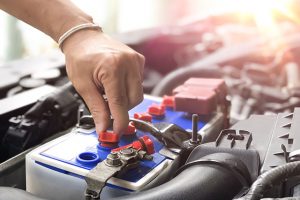
When your vehicle’s engine is off, the battery provides the required power to the rest of the system, as well as during start-up (cranking). It also supplements the power from the charging system during periods of high demand. Your vehicle’s electrical system powers everything from the ignition and fuel systems to accessories such as your radio, headlights and wipers. The electrical system is, in turn, powered by the engine. Here are the three key components of the electrical system: Battery, Charging System, Starting System.

Exposure to heat, vibration and contamination makes belts and hoses wear out faster than any other components in your vehicle.. That’s why regular inspections are so important. Here are the belt and hose types in your vehicle, along with their applications.
- Alternator
- Water Pump for engine cooling
- Power Steering Pump
- Air Conditioning Compressor
- Radiator Cooling Fan
- Many late model vehicles use a single serpentine belt in place of individual belts to drive these accessories.
- Radiator and Heater Hoses – These hoses convey coolant to the engine and heater core.
- Fuel Hose – As the name implies, this hose transports gasoline from the tank to the engine.
- Power Steering Hose – It connects the power steering pump to the steering gear.
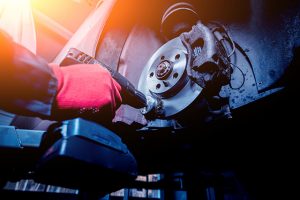
When it comes to auto repair in Evansville, Indiana, brakes are one of the most important safety features that your vehicle offers. Brakes should be inspected frequently to ensure the safety of both you and your passengers. Squeaking is not the only sign that your brakes may need replacement. Grinding, vibration when braking, a squishy feel when you push your brake pedal down, or your vehicle pulling to one direction when braking. Frequent requests for brake inspections to look for issues with uneven pad wear or rotors that need turning quicker than pad replacement is needed is a good way to make sure that your vehicle has the optimum ability to brake when you need it most. If you are experiencing any of these symptoms, please bring your vehicle in as soon as possible so we can inspect and recommend any repairs or replacements that may be needed.
The brake system is actually composed of two kinds of systems—Hydraulics and Friction Materials.
Hydraulics
- Master Cylinder
- Brake Lines and Hoses
- Wheel Cylinders and Calipers
Friction Materials
- Disc Brake Pads and Drum Brake Shoes
Types of Brakes
- Disc Brakes
- Drum Brakes
- Parking Brake
- Anti-Lock Brakes: A System Built For Safety
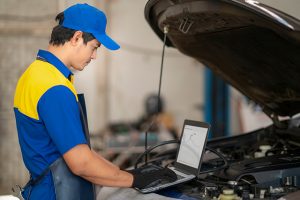
Your vehicle’s engine is a highly sophisticated piece of equipment. Federal Exhaust Emission and Fuel Economy regulations demand that today’s vehicles be equipped with electronic engine control systems, to curb carbon emissions and increase fuel efficiency. With technically-advanced control systems taking the place of simple engine components, common maintenance services such as tune-ups are also a thing of the past. Regular services (such as spark plug and filter replacements) are still required, as well as a computerized analysis of your vehicle’s control computer. Our trained technicians are here to provide these basic services.
A network of sensors and switches convert and monitor engine operating conditions into electrical signals. The computer receives this information, and, based on information and instructions coded within this computer program, commands are sent to three different systems: ignition, fuel, and emission control. Whenever a problem arises (as seen by that nagging “check engine” light), our techs check whatever command is prompted, in addition to the status of your engine control computer and sensors. That way you’ll know if your vehicle’s performance is caused by a real problem, or just a sensor/computer issue.
Vehicle sensory components:
- Mass airflow sensor
- Throttle position sensor
- Manifold absolute pressure sensor
- Coolant temperature sensor
- Exhaust oxygen sensor
- Crankshaft position sensor
- Camshaft position sensor
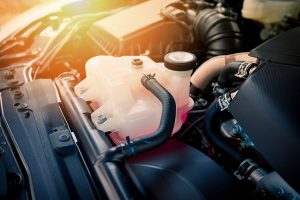
Heating and Air Conditioning Systems
Visual Inspection
- Interior controls and blower
- Radiator coolant level, hoses, pressure cap and thermostat
- The A/C compressor belt for condition and tension
- Leaks or other damage
- Component condition, leaks or damage
Heating and Air Conditioning Tests
- Pressure test engine cooling system
- A/C system pressures are measured and compared to manufacturer’s specifications
- A/C system is leak tested
- Both the heater and A/C are performance tested by checking the outlet air temperature at the discharge vents

Your vehicle’s axle must bear the weight of your vehicle (plus any cargo) and the acceleration forces between you and the ground. So when it comes to axle inspection, we are your source for professional, knowledgeable service-essential for the equipment that carries you and your family to wherever you need to go.
A drive axle is one that is driven by the engine. A drive axle is split between two half axles, with differential and universal s between them. Each half axle is connected to the wheel by a third joint-the constant velocity (CV) joint-that allows the wheels to move freely. This joint allows the shaft to rotate, transmitting power at a constant speed without a significant increase in friction and heat. CV joints are usually dependable, but, as is the case for all of your vehicle’s moving equipment, they do require regular inspection. An easy way for you to tell if you need to see us for axle repair is to go out to a large space (such as a parking lot), and slowly drive in tight circles. If you hear a clicking or cracking noise, you have a worn joint, and it must be repaired immediately.
We will have you back on the road, “click-free” in no time!
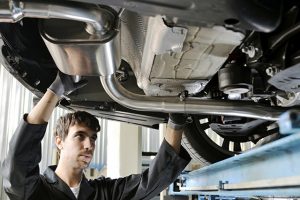
Your exhaust system is more than a muffler. It is a series of pipes that run under your vehicle, connected to your muffler and catalytic converter. The main function of your exhaust system is to control noise and to funnel exhaust fumes away from passengers. A vehicle”s exhaust system routes waste gases from the engine to the rear of the vehicle, where they are discharged into the atmosphere. Exhaust gases contain dangerous substances such as carbon monoxide, which can be hazardous if allowed to flow into the passenger housing of the vehicle. The exhaust system also converts pollutants into less harmful byproducts, reduces the noise of the engine, and directs exhaust gases so they can be used to heat air and fuel before they go into the engine’s cylinders to be burned. Finally, the exhaust system provides just the right amount of backpressure into the engine to improve its fuel-burning efficiency and increase performance. Key components of your exhaust system include:
- Exhaust Pipes
- Exhaust Manifold
- Catalytic Converter
- Muffler
- Resonator
- Tail Pipe

If you are experiencing rough idle, stalling, poor acceleration, lower fuel economy or high emissions levels, then a Fuel Injection Service could help your vehicle’s performance. Fuel injectors can clog when deposits build up over time. The type of gas can also contribute to this concern. The EPA requires specific detergents be added to our fuel to prevent widespread issues of carbon deposits building up in the system, but often lower priced brands use the minimum amounts of these detergents and can cause problems. This is one of the main reasons certain manufacturers recommend specific gasoline for their vehicles, to maintain better performance over a longer period of time.

Follow your vehicle manufacturer’s recommendation, for oil changes based on your individual driving habits and conditions, and have the oil changed accordingly. As a top choice for auto repair in Evansville, Indiana we know typically this can range anywhere from 3000 – 7,500 miles. We will perform an oil and filter change service which includes a new filter, 5 quarts of new oil, using the oil type recommended for your vehicle, including synthetic blend, high-mileage, or full-synthetic oil. We will top off your fluids and we will check other filters, including the air filter, cabin filter, and fuel filter. We also check your vehicle’s engine belts, hoses, and windshield wipers. As well as topping off all vehicle fluids. Contact us today to set up your oil change or auto repair in Evansville, Indiana!
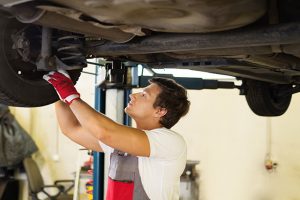
The primary function of your vehicle’s suspension and steering systems is to allow the wheels to move independently of the vehicle, while keeping it “suspended” and stable. Any play or uncontrolled motion in these systems results in a deterioration of handling and accelerated tire wear. Vehicle alignment is closely tied to the condition of the suspension and steering systems.
Steering Systems
Worn or loose components affect the ability to control the toe angle, and may result in a loss of directional stability and accelerated tire wear. The main components of a Conventional system are:
- Steering Gear Box
- Center Link
- Pitman Arm
- Idler Arm
- Tie Rods
The main components of a Rack and Pinion steering system are:
- Rack and Pinion Assembly
- Bellows Boots
- Tie Rods
Suspension System
Worn or loose components affect the suspension systems ability to control motion and alignment angles, resulting in a deterioration of vehicle handling and stability, and accelerated tire wear. The main components of the suspension system are:
- Control Arms
- Ball Joints
- Springs (Coil or Leaf)
- Shock Absorbers
- Struts
Affiliations






